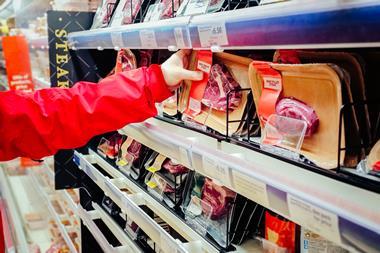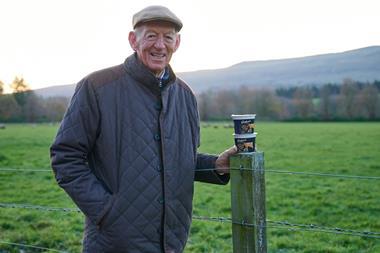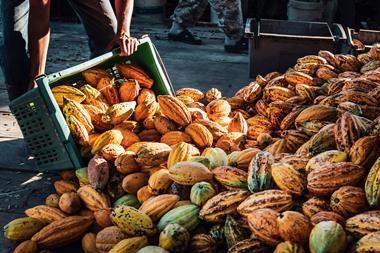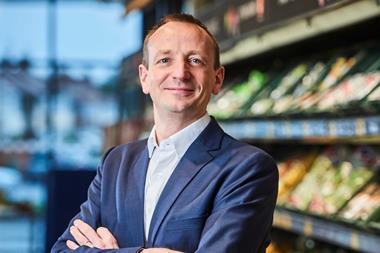After growing strongly, the yoghurts & pot desserts category has slowed as commodity hikes have hit home. Could big pots and big brands hold the answer, asks Simon Creasey
Sales in the yoghurts & pot desserts category haven't quite gone to pot but they're not exactly booming.
After a strong 2009, the category has struggled to maintain strong growth over the past year. Total value growth has slipped back to 2.9% and volume growth has fallen to 3.9% despite high levels of NPD and promotions.
That volume growth is outstripping value growth suggests that the high level of promotional activity is undermining value. Closer scrutiny of the promotional landscape reveals a more complex set of dynamics at work, however.
"Although the level of promotions has remained the same, there is evidence of a slight shift, with some offers becoming less deep, perhaps reflecting an appreciation of the increasing commodity prices being seen by all dairy manufacturers," notes Matthew Wilson, spokesman for Emmi-owned yoghurt brand Onken.
If that were the case, you'd expect the average price of yoghurts & pot desserts to have gone up. But while chilled desserts have gone up in price which has led to a decline in volumes Kantar records a fall in average price across yoghurts, which has encouraged people to buy more per trip and contributed to a 5.1% growth in volumes. So what's going on?
Unfortunately, there is no simple answer. What is clear is that much of last year's growth was driven by commodity-driven price rises and there's only so much consumers can take.
Over the past year, they've voted with their feet as far as chilled desserts go, two consecutive years of price rises contributing to massive slowdown in value growth, from 9.8% to 3.5%, and a 0.1% fall in volume. It might not sound like much but compared with 5.8% growth in 2009, it's quite a reversal of fortunes.
With yoghurts, on the other hand, although there arguably remains too much promotional activity, it's clearly working. The sub-category also boasts more heavyweight brands than the predominantly own-label dominated chilled desserts category brands that are not only more appealing to consumers in the current economic climate but that are also raising their games on the NPD front, especially when it comes to big pots.
Big pots have been the big story of the past couple of years and even though they only make up a small part of the yoghurt market, they're the fastest growing, with sales up to £192m a year and growing at a rate of 6.1%, according to Wilson.
Clearly NPD has played a part in swelling the ranks of the big pots but their success is also down to another key factor. "Big pots offer great value for money compared with smaller pots," says Wilson.
That's not to say there are not barriers to purchases. Their relatively high unit price compared with a small pot can put consumers off, as can the fact they're not as flexible as single-serve pots, which is why manufacturers are looking to broaden the use of big pots.
Onken, for instance, is investing an initial £500,000 on a promotion called Love Me or Your Money Back, which "takes the risk out of this purchase", says Wilson. "And we have created more than 160 recipe suggestions as to how to use yoghurt in cooking. We expect this to generate a considerable number of new consumers."
Emmi's acquisition of Onken from Dr Oetker last November will also act as a spur to the brand's growth, believes Wilson. "It will get the focus and investment that the brand needs," he says. "Although Dr Oetker invested in the brand and grew value from £30m in 2006 to £49m at the end of January 2010, it was never a strategic portfolio for them. For Emmi it is and will be and, as such, will get increased investment."
If you want to attract new consumers to a relatively underdeveloped category it also pays to tweak the format, it seems. Dutch yoghurt and pot dessert producer De Zuivelhoeve, which launched the Twekkelo brand into the UK in 2010, is enjoying solid growth in sales of its 'bucket' yoghurts, which come in flavours such as apple & cinnamon, black cherry and forest fruit.
Twekkelo's UK manager, Steve Johnson, says that the bucket provides stand-out on shelf, but what wins repeat purchase is the quality of the product. "We're in big pots and we have quite distinctive packaging, but what we're establishing ourselves as is a brand known for providing high-quality yoghurt with tasty fruit combinations."
Another supplier exploring the big pot format is Brown Cow Organic (see right). Little Melton, meanwhile, has just launched a big tub (also right) that will test consumer appetite for an even more premium offering. And Danone upped the ante on the format and product front with the launch of its Activia Pouring Yoghurt in a carton in October.
That's not to say everyone is taking the view that big is best. Yoplait is forging ahead with the rollout of its luxurious Perle de Lait range of four-yoghurt packs aimed at women aged 35 years-plus.
Yoplait's UK category controller Nicola Dean concedes that the company took a risk with the new lines, which were launched in January last year and come in coconut, mango & passionfruit, strawberry and lemon flavours, but says it is delighted with sales so far. "The brand was unknown in the UK when we launched it, so we had to invest heavily in a TV campaign to raise awareness. It's now a £4m brand and, although we're pleased with what it's done so far, we can do more."
So there's been exciting NPD at both ends of the size spectrum in yoghurts. In chilled desserts, though, it's 'Dine in for £10' style meal deals (as well as price rises) that are primarily driving value growth. "Consumers are looking for 'restaurant-style' experiences at home," says Ciaran Sullivan, MD for Lactalis-Nestlé UK and Ireland. "Continental desserts are seen as more sophisticated and more akin to what you would buy when dining out, so have done well as a result."
To tap into this trend, Bonne Maman launched a Continental-style range of pot desserts into stores last month. The range includes the likes of Tarte au Citron meringue pie, Baba Au Rhum, chocolate mousse and crème caramel as well as yoghurts with 'confiture'. "What we bring to the market is greater consumer choice," says Bonne Maman UK marketing manager Severine Brault. "As a French brand much loved and trusted by the UK consumer, our desserts are classics of their kind."
As well as introducing more Continental desserts to the chiller aisle, Bonne Maman is launching a rich rice 'Gourmand' pudding. The traditional British staple is still striking a chord with consumers, according to Tideford Organics MD Lynette Sinclair.
"We have seen an increase in the sales of our rice puddings and it appears that there is still very much a demand for authentic, traditional English recipes," she says. "Organic rice puddings do well because they offer indulgence with none of the additives or preservatives often associated with dessert pots."
That may be so, but Lactalis-Nestlé's Sullivan believes that brands need to look beyond this type of 'safe bet' product. "There is a risk that unless manufacturers enter 'new' segments, the traditional desserts segments that are strong with brands such as rice pudding or mousse will continue to be squeezed by the growth in the own label-led 'pure indulgence' segments," he says.
Pot dessert manufacturers will need to innovate outside their current comfort zone if they want to generate strong value and volume growth, but in yoghurts, provenance continues to be an important factor and one that a number of brands highlight, from category behemoths like Müller, through to smaller operators such as Twekkelo.
The latter prints information on its packaging highlighting the family heritage of the product or the 'cow comfort' programme adopted by its farmers. "Brand authenticity and animal welfare have become desirable factors when consumers purchase dairy," explains Johnson.
Yeo Valley, meanwhile, gave us rapping farmers (see box p49). "Our consumer communications reinforce the heritage and provenance behind the Yeo Valley brand by showing that Yeo Valley is a real place in the heart of the Somerset countryside," says Ben Cull, Yeo Valley's head of brand marketing. "Where some brands need to create this provenance, for us it's real. Our recent TV ad was shot on location in Blagdon and the homepage of our website is a view from our office window."
The company's tactics appear to be working. Cull says that in the latest 12-week data, Yeo Valley's household penetration stands at 21.3%, up 1.6%, with 5.3 million households now buying into the brand this despite the fact that organic products in general are struggling.
Steve Clarke, marketing manager at Rachel's, confirms that the performance of organic in 2010 was broadly flat, with value sales down 1.2% and volume down 0.6%. However, he sees this as a positive sign that organic products have arrested the dramatic downward trend witnessed in 2009, where sales of own-label yoghurts to give just one example slumped 41.2% [Kantar].
"Rachel's had a very strong year last year, up 13.5% in volume driven by new flavours, improved rate of sale and distribution increases," says Clarke. "Being organic is important to us but what's also important is that we do things differently and deliver superior textures and flavours. Being organic is sometimes not enough. You need to bring something else to the equation to make it work."
It's a view shared by Sally Dorling of Tims Dairy. She feels the perception of organic has shifted over the course of the economic downturn. "I don't think that being organic is a main sales point for products anymore," says Dorling. "It used to have its own category but now it blends into every category and has become more part of the mainstream."
Sales of organic products are on the mend she believes, thanks largely to the fact that manufacturers like Rachel's and Yeo Valley can compete on the same pricing playing field as rival non-organic producers.
Cull echoes her sentiment. "Our products are in price parity with many of the non-organic products on the shelves and we believe this is critical in helping to dispel the myth that just because we are organic it doesn't automatically equate to premium, niche and expensive products," he says. Not that premium products are necessarily expensive.
Even premium products are often available on cut-price multibuy deals. Louisa Gould, Danone category strategy manager, confirms that the level of promotional activity is still running at high levels with "volume sold on deal at 56% in the latest 52 weeks and 54% in the latest 12 weeks" [Nielsen].
Müller marketing director Lee Rolston agrees promotions remain an important part of the marketing mix, but warns manufacturers not to get too obsessed with deals. "It's vital that with so much focus being given to price deals, suppliers and retailers don't lose sight of the role of other types of promotions. That is what pulls in consumers and builds loyalty."
To this end, Müllerlight launched a Win a £1,000 Shopping Spree Every Day on-pack promotion in January, which helped it boost sales 10.8% on January 2010, claims Rolston. It's a strategy that the company intends to build on throughout 2011.
The focus will be as much on core brands as new ones, he says. "In today's market you have to make a big impact in a small time frame so any new product has to be different enough and big enough to build scale and achieve significant cut through in just 12 weeks," he says. "That's why the category has seen more brand renovation and brand extensions than pure NPD launches recently."
So what of the future for yoghurts and pot desserts? The next 12 months will certainly herald further commodity price rises, according to Rachel's Clarke. "Brands and manufacturers will need to be creative with efficiencies and cost savings before considering passing these costs on to retailers and consumers," he says.
Organic and functional products are also expected to gain ground. "The healthy yoghurts category has grown 5.5% since last year, now accounting for 35% of the yoghurts market," says Benecol Europe's associate franchise director Esther van Onselen. As for the rest of the category, Rolston predicts polarisation.
"I foresee growth at the top end of the category with the primary and most popular brands increasing their dominance at the expense of secondary and tertiary brands, which are going to be squeezed and will face tough challenges."
With commodity price rises set to bring further pain to the entire category, it may come down to pot luck.
Focus On Yoghurts & Pot Desserts
Sales in the yoghurts & pot desserts category haven't quite gone to pot but they're not exactly booming.
After a strong 2009, the category has struggled to maintain strong growth over the past year. Total value growth has slipped back to 2.9% and volume growth has fallen to 3.9% despite high levels of NPD and promotions.
That volume growth is outstripping value growth suggests that the high level of promotional activity is undermining value. Closer scrutiny of the promotional landscape reveals a more complex set of dynamics at work, however.
"Although the level of promotions has remained the same, there is evidence of a slight shift, with some offers becoming less deep, perhaps reflecting an appreciation of the increasing commodity prices being seen by all dairy manufacturers," notes Matthew Wilson, spokesman for Emmi-owned yoghurt brand Onken.
If that were the case, you'd expect the average price of yoghurts & pot desserts to have gone up. But while chilled desserts have gone up in price which has led to a decline in volumes Kantar records a fall in average price across yoghurts, which has encouraged people to buy more per trip and contributed to a 5.1% growth in volumes. So what's going on?
Unfortunately, there is no simple answer. What is clear is that much of last year's growth was driven by commodity-driven price rises and there's only so much consumers can take.
Over the past year, they've voted with their feet as far as chilled desserts go, two consecutive years of price rises contributing to massive slowdown in value growth, from 9.8% to 3.5%, and a 0.1% fall in volume. It might not sound like much but compared with 5.8% growth in 2009, it's quite a reversal of fortunes.
With yoghurts, on the other hand, although there arguably remains too much promotional activity, it's clearly working. The sub-category also boasts more heavyweight brands than the predominantly own-label dominated chilled desserts category brands that are not only more appealing to consumers in the current economic climate but that are also raising their games on the NPD front, especially when it comes to big pots.
Big pots have been the big story of the past couple of years and even though they only make up a small part of the yoghurt market, they're the fastest growing, with sales up to £192m a year and growing at a rate of 6.1%, according to Wilson.
Clearly NPD has played a part in swelling the ranks of the big pots but their success is also down to another key factor. "Big pots offer great value for money compared with smaller pots," says Wilson.
That's not to say there are not barriers to purchases. Their relatively high unit price compared with a small pot can put consumers off, as can the fact they're not as flexible as single-serve pots, which is why manufacturers are looking to broaden the use of big pots.
Onken, for instance, is investing an initial £500,000 on a promotion called Love Me or Your Money Back, which "takes the risk out of this purchase", says Wilson. "And we have created more than 160 recipe suggestions as to how to use yoghurt in cooking. We expect this to generate a considerable number of new consumers."
Emmi's acquisition of Onken from Dr Oetker last November will also act as a spur to the brand's growth, believes Wilson. "It will get the focus and investment that the brand needs," he says. "Although Dr Oetker invested in the brand and grew value from £30m in 2006 to £49m at the end of January 2010, it was never a strategic portfolio for them. For Emmi it is and will be and, as such, will get increased investment."
If you want to attract new consumers to a relatively underdeveloped category it also pays to tweak the format, it seems. Dutch yoghurt and pot dessert producer De Zuivelhoeve, which launched the Twekkelo brand into the UK in 2010, is enjoying solid growth in sales of its 'bucket' yoghurts, which come in flavours such as apple & cinnamon, black cherry and forest fruit.
Twekkelo's UK manager, Steve Johnson, says that the bucket provides stand-out on shelf, but what wins repeat purchase is the quality of the product. "We're in big pots and we have quite distinctive packaging, but what we're establishing ourselves as is a brand known for providing high-quality yoghurt with tasty fruit combinations."
Another supplier exploring the big pot format is Brown Cow Organic (see right). Little Melton, meanwhile, has just launched a big tub (also right) that will test consumer appetite for an even more premium offering. And Danone upped the ante on the format and product front with the launch of its Activia Pouring Yoghurt in a carton in October.
That's not to say everyone is taking the view that big is best. Yoplait is forging ahead with the rollout of its luxurious Perle de Lait range of four-yoghurt packs aimed at women aged 35 years-plus.
Yoplait's UK category controller Nicola Dean concedes that the company took a risk with the new lines, which were launched in January last year and come in coconut, mango & passionfruit, strawberry and lemon flavours, but says it is delighted with sales so far. "The brand was unknown in the UK when we launched it, so we had to invest heavily in a TV campaign to raise awareness. It's now a £4m brand and, although we're pleased with what it's done so far, we can do more."
So there's been exciting NPD at both ends of the size spectrum in yoghurts. In chilled desserts, though, it's 'Dine in for £10' style meal deals (as well as price rises) that are primarily driving value growth. "Consumers are looking for 'restaurant-style' experiences at home," says Ciaran Sullivan, MD for Lactalis-Nestlé UK and Ireland. "Continental desserts are seen as more sophisticated and more akin to what you would buy when dining out, so have done well as a result."
To tap into this trend, Bonne Maman launched a Continental-style range of pot desserts into stores last month. The range includes the likes of Tarte au Citron meringue pie, Baba Au Rhum, chocolate mousse and crème caramel as well as yoghurts with 'confiture'. "What we bring to the market is greater consumer choice," says Bonne Maman UK marketing manager Severine Brault. "As a French brand much loved and trusted by the UK consumer, our desserts are classics of their kind."
As well as introducing more Continental desserts to the chiller aisle, Bonne Maman is launching a rich rice 'Gourmand' pudding. The traditional British staple is still striking a chord with consumers, according to Tideford Organics MD Lynette Sinclair.
"We have seen an increase in the sales of our rice puddings and it appears that there is still very much a demand for authentic, traditional English recipes," she says. "Organic rice puddings do well because they offer indulgence with none of the additives or preservatives often associated with dessert pots."
That may be so, but Lactalis-Nestlé's Sullivan believes that brands need to look beyond this type of 'safe bet' product. "There is a risk that unless manufacturers enter 'new' segments, the traditional desserts segments that are strong with brands such as rice pudding or mousse will continue to be squeezed by the growth in the own label-led 'pure indulgence' segments," he says.
Pot dessert manufacturers will need to innovate outside their current comfort zone if they want to generate strong value and volume growth, but in yoghurts, provenance continues to be an important factor and one that a number of brands highlight, from category behemoths like Müller, through to smaller operators such as Twekkelo.
The latter prints information on its packaging highlighting the family heritage of the product or the 'cow comfort' programme adopted by its farmers. "Brand authenticity and animal welfare have become desirable factors when consumers purchase dairy," explains Johnson.
Yeo Valley, meanwhile, gave us rapping farmers (see box p49). "Our consumer communications reinforce the heritage and provenance behind the Yeo Valley brand by showing that Yeo Valley is a real place in the heart of the Somerset countryside," says Ben Cull, Yeo Valley's head of brand marketing. "Where some brands need to create this provenance, for us it's real. Our recent TV ad was shot on location in Blagdon and the homepage of our website is a view from our office window."
The company's tactics appear to be working. Cull says that in the latest 12-week data, Yeo Valley's household penetration stands at 21.3%, up 1.6%, with 5.3 million households now buying into the brand this despite the fact that organic products in general are struggling.
Steve Clarke, marketing manager at Rachel's, confirms that the performance of organic in 2010 was broadly flat, with value sales down 1.2% and volume down 0.6%. However, he sees this as a positive sign that organic products have arrested the dramatic downward trend witnessed in 2009, where sales of own-label yoghurts to give just one example slumped 41.2% [Kantar].
"Rachel's had a very strong year last year, up 13.5% in volume driven by new flavours, improved rate of sale and distribution increases," says Clarke. "Being organic is important to us but what's also important is that we do things differently and deliver superior textures and flavours. Being organic is sometimes not enough. You need to bring something else to the equation to make it work."
It's a view shared by Sally Dorling of Tims Dairy. She feels the perception of organic has shifted over the course of the economic downturn. "I don't think that being organic is a main sales point for products anymore," says Dorling. "It used to have its own category but now it blends into every category and has become more part of the mainstream."
Sales of organic products are on the mend she believes, thanks largely to the fact that manufacturers like Rachel's and Yeo Valley can compete on the same pricing playing field as rival non-organic producers.
Cull echoes her sentiment. "Our products are in price parity with many of the non-organic products on the shelves and we believe this is critical in helping to dispel the myth that just because we are organic it doesn't automatically equate to premium, niche and expensive products," he says. Not that premium products are necessarily expensive.
Even premium products are often available on cut-price multibuy deals. Louisa Gould, Danone category strategy manager, confirms that the level of promotional activity is still running at high levels with "volume sold on deal at 56% in the latest 52 weeks and 54% in the latest 12 weeks" [Nielsen].
Müller marketing director Lee Rolston agrees promotions remain an important part of the marketing mix, but warns manufacturers not to get too obsessed with deals. "It's vital that with so much focus being given to price deals, suppliers and retailers don't lose sight of the role of other types of promotions. That is what pulls in consumers and builds loyalty."
To this end, Müllerlight launched a Win a £1,000 Shopping Spree Every Day on-pack promotion in January, which helped it boost sales 10.8% on January 2010, claims Rolston. It's a strategy that the company intends to build on throughout 2011.
The focus will be as much on core brands as new ones, he says. "In today's market you have to make a big impact in a small time frame so any new product has to be different enough and big enough to build scale and achieve significant cut through in just 12 weeks," he says. "That's why the category has seen more brand renovation and brand extensions than pure NPD launches recently."
So what of the future for yoghurts and pot desserts? The next 12 months will certainly herald further commodity price rises, according to Rachel's Clarke. "Brands and manufacturers will need to be creative with efficiencies and cost savings before considering passing these costs on to retailers and consumers," he says.
Organic and functional products are also expected to gain ground. "The healthy yoghurts category has grown 5.5% since last year, now accounting for 35% of the yoghurts market," says Benecol Europe's associate franchise director Esther van Onselen. As for the rest of the category, Rolston predicts polarisation.
"I foresee growth at the top end of the category with the primary and most popular brands increasing their dominance at the expense of secondary and tertiary brands, which are going to be squeezed and will face tough challenges."
With commodity price rises set to bring further pain to the entire category, it may come down to pot luck.
Focus On Yoghurts & Pot Desserts


















No comments yet